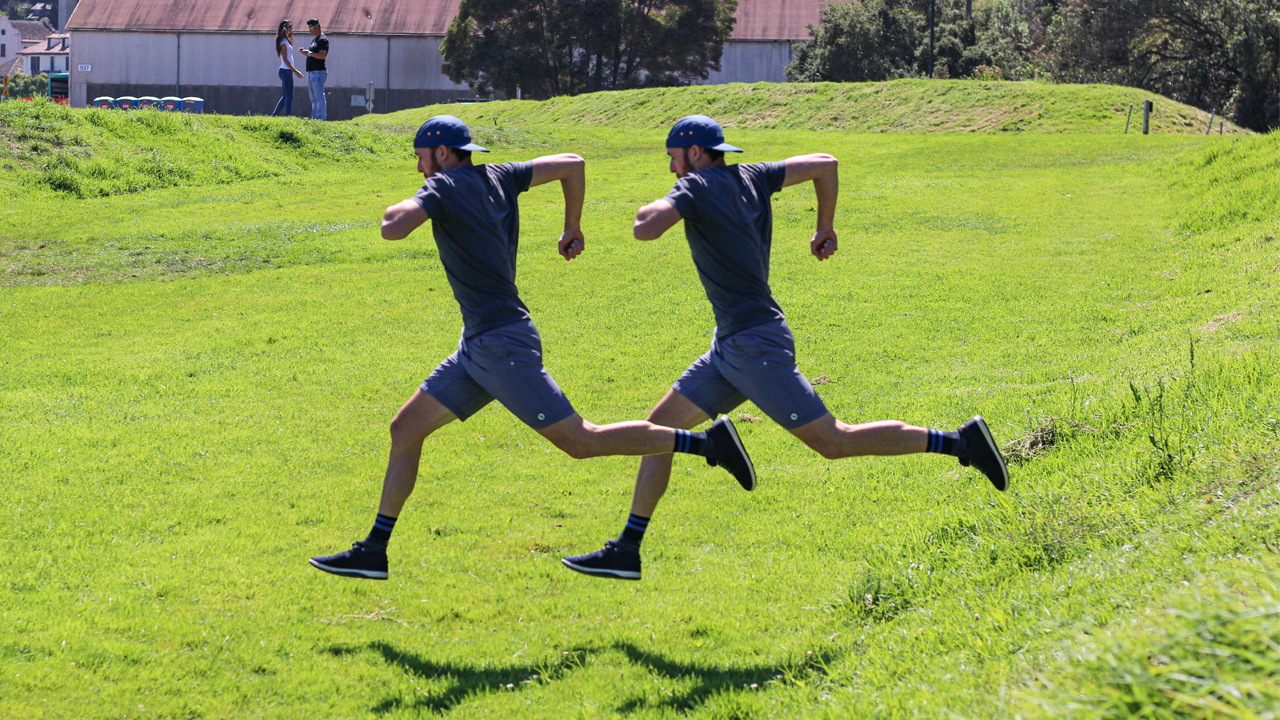Running Twice a Day (Strategies, Tips, & Benefits)
Running twice a day can be beneficial if it's done safely. Try these tips to minimize injury risk and maximize the benefits of double running.

Running twice a day can benefit your training plan if done safely and intentionally — and guess what? It's not just for elite athletes anymore. Both experienced runners and newcomers to the sport can use double running to maximize their performance.
But we know you've got questions swirling in your mind:
- Should beginners workout twice a day? We'll help you ease into it.
- Is it ok to workout twice a day? Spoiler alert: it can be, but we'll show you how to do it right.
- Is running twice a week enough when you're training for a race? Well, that depends — and we'll break it down for you.
It's a lot of "twice" talk, but don't worry — we've got your back. We're about to dive into all things double runs, covering the ins and outs of how to incorporate this strategy into your training. Whether you're looking to boost your mileage, manage a tight schedule, or just shake things up, we'll guide you through the process of running twice a day without running yourself into the ground.
What Do We Mean by Running Twice a Day?
Running twice a day, often referred to as "double runs," involves splitting your daily running workout into two separate sessions. This approach can be particularly beneficial for increasing overall mileage, enhancing recovery, and managing time more effectively.
Typically, the first run of the day focuses on a key workout, such as a longer distance run, interval training, or a tempo run. This session takes advantage of the body's rested state to tackle more demanding workouts.
The second run, usually shorter and at a lighter intensity, might serve several purposes. It can enhance recovery by promoting blood flow to tired muscles, add extra mileage without a significant increase in injury risk, or simply shake off the day's stress.
And it's got some sweet perks:
- Mileage boost: You can rack up more weekly miles without the wear and tear of one super long run.
- Recovery enhancer: That second run can actually help you bounce back faster by promoting blood flow to your tired muscles.
- Time management magic: Can't fit in one long run? Split it up and make it work for your schedule.
- Stress buster: Nothing like an evening jog to shake off the day's worries.
So there you have it — running twice a day in a nutshell.
Benefits of Running Twice a Day
- Increased Mileage: Splitting runs allows for a higher weekly mileage, which is crucial for advanced runners aiming to improve endurance and performance.
- Improved Recovery: The second, lighter run can act as active recovery, facilitating muscle repair and adaptation.
- Flexibility: For runners juggling busy schedules, double runs can make it easier to fit training into their day, breaking up the workload into more manageable segments.
- Stimulation of Metabolism: Running twice can keep the metabolism elevated for longer periods, potentially benefiting weight management efforts.
Running twice a day is generally more suited to experienced runners who have built a solid base of mileage and have specific training goals, such as preparing for a marathon or improving race times. It's crucial to listen to your body and ensure adequate nutrition and recovery between sessions to avoid overtraining and injury.
Why Run Twice a Day?
In this article, we’ll cover why running twice a day might be a good option for you and how to run safely to avoid injury risk.

If you’re a student-athlete, you might be required to run twice a day, whether you’re doing two-a-day practices or just being required to run once on your own and once in practice.
If you’re training for a distance race, running twice a day might be the only way to reach your weekly mileage given your everyday schedule.
Or if you’re an ultra runner, two-a-day runs might be necessary to get your body used to spending that much time on your legs.
No matter your situation, breaking up your runs into two separate runs is an excellent tool to help your run form. In a long run, whatever that distance might be for you, your form can suffer as you get tired. And when run form suffers, injury risk goes up.
If you divide your daily run between two shorter runs and run with good form through each run, you will be better off in the long run (pun may be intended here 😉 ). Not only will you be less prone to injury, but you will have trained your body to run with proper form only. You will build your muscle memory to know only proper run form.
Forcing adaptation through double running
Another benefit of double runs is forcing your body to train on tired legs. Even if you are doing daily runs, they are all runs on relatively fresh legs, or at least legs that have had the benefit of sleep.
And when you reach mile 10 of your half marathon, let’s say your legs might not feel so fresh; this is where it helps to have trained on tired legs; your body will be familiar with the feeling.
Lastly, running twice a day might be more convenient, especially if running long distances. By breaking up your long run into two runs, you do not need to pack all the fuel and electrolytes you would need for the long run; you can just head out the door.
It will also be easier to finding routes for each run because you won’t have to consider if there are places to fill up your water or if there’s a bathroom along the way. If you don’t have enough time to prepare before your long run, consider breaking it into two and heading out the door.
How to Run Twice A Day: Best Practices
To begin, we are not recommending that you run twice a day every day. Instead, these tips help you when you run twice a day, but your training schedule should mix up your training to incorporate strength training, rest days, and mobility work.
But for the days you run twice a day, here are some tips vital to minimizing injury risk and maximizing the benefits of double runs.
1: Don’t skip warm-ups and cooldowns on your workout days.

Just because you have another run coming up later in the day does not mean you can skip the cooldown from your first run. And just because you ran earlier does not mean you can skip the warm-up for your second run. Running twice a day doubles any risk of injury you would have with only one run in a day. This means taking care of yourself before and after your runs is much more important. Treat each run as if it’s the only run you’re doing that day regarding the warm-up and cooldown. You don’t need to take extra time with either of these, but just be sure you’re not skipping them. This will improve blood flow and circulation throughout your runs.
2: Work in strength training at least once a week.

As we said earlier, your second run is taking place on tired legs in a depleted state, and those tired legs need to be strong enough to get you through the run and keep you injury-free. To do this, make strength training a priority. If your training schedule does not already have strength training worked in, find the time for it.
Simple exercises like lunges, air squats, push-ups, and core work can all be very effective if done with proper form, and they do not take up much space if you don’t have enough time to get to the gym. You can try plenty of online workouts if you’re not sure how to structure your strength workout. Just ensure you incorporate it no matter how or where you do your strength training. Insert workout video clip.
3: Fuel and hydrate intentionally.
Think ahead here. Keep your second run in mind when fueling after your first run, and know your distances ahead of time. For instance, if your first run of the day is easy, but your second run is going to be longer, schedule your larger meals accordingly.
This process might look different for everyone, as running nutrition is highly individual. All we’re saying is to plan ahead intentionally. If you know you don’t like a larger meal before a longer run, hold off on dinner until that longer run is over, and eat smaller meals throughout the day. If you know you have a tempo run in the morning, consider eating a lighter breakfast and consuming that larger meal once your tempo run is over.
If you are running for weight loss, diet plays a huge role. Running doubles does not have to change your meal plan, but it may change the timing of your meal plan depending on your mileage.
Hydration also becomes important when you’re running twice a day. Hydrate consistently throughout the day, and consider increasing the amount of fluids you drink when you only have one workout that day. If you don’t you will feel the effects of it on one, if not both, of your runs. Minimize the chances of cramping or injuries during either of your runs by simply drinking water and electrolytes regularly throughout the day.
And for higher mileage runs, let’s say anything longer than an hour, you will likely need to bring supplies with you on the run – fluids for sure, and maybe a gel or an energy block if your body needs it.
4: Sleep!
Doubling up on your training heightens the importance of sleep. While going to bed earlier is a great option for those running two a day, it’s not the only option. Naps are your friend. Even just a fifteen or twenty nap during the day can help get your blood flow going the other way and help reset your body and mind for your second run that day.
5: Cross-train strategically.
Instead of running twice daily, consider training twice a day with another exercise. That might involve running once and lifting once for a twice-a-day workout. This puts less strain on your running muscles (and gives them time to recover) while you work other muscles.
Training twice a day
For example, you might run in the morning and then cross-train in the afternoon with upper-body workouts. Or you might do some cycling to work other muscles of your body that don’t get prioritized during a run.
Should beginners workout twice a day?
Good question. We recommend working into it. You can’t rush progress, and working out twice a day could increase your risk of injury at first.
We get it: time is short. But you have to make time for recovery and adaptations. Take it easy, and be patient. Progress will come.
6: Do Running Doubles Smartly
To do running doubles safely, you must be smart about it. First, figure out why you want to do running doubles instead of just one longer workout.
What’s the benefit? Are you too tired from the first workout? Do you not have enough bulk time in the day to get it all done in one session (short lunch break, commutes, etc.)?
Running doubles can yield great physical gains, but you must do it smartly. It’s a high demand on the body, and when you train hard, you have to
Frequently Asked Questions
Can you run twice a day?
Of course. Should you?
That’s a different question.
Running twice a day isn't just for elite athletes with superhuman recovery powers. Almost anyone can do it — but that doesn't mean everyone should. It's like having dessert for every meal: technically possible, but not always the best choice for your body.
Double runs can boost your weekly mileage faster than you can say "PR," but they also cut into your recovery time. And let's face it — recovery is where the magic happens. It's when your body repairs itself and gets stronger. So while you're doubling up on runs, you might be shortchanging your gains.
Is running twice a day good for weight loss?
Ah, the million-dollar question! Running twice a day can indeed help with weight loss — you're burning more calories, after all. But here's the catch: it also increases your risk of injury. And nothing derails a weight loss journey faster than being sidelined with a bum knee or angry IT band.
Our take? It's not always the best strategy. Instead of doubling up on runs, why not focus on quality over quantity? Mix up your running with some strength training, dial in your nutrition, and prioritize recovery. It's less about running more and more about running smart.
Is it bad to run twice a day?
"Bad" is a strong word — we prefer to think of it as "challenging" or "advanced." Running twice a day isn't inherently harmful, but it does come with its own set of pros and cons.
On the plus side, you've got increased mileage, potential fitness gains, and the flexibility to fit running into a busy schedule. On the flip side, there's a higher risk of burnout, overuse injuries, and less recovery time.
The key is to listen to your body. If you're constantly feeling wiped out or nursing nagging injuries, it might be time to dial it back.
What’s your advice for running twice a day for beginners?
We love your enthusiasm, but jumping into double runs too quickly is like trying to run a marathon when you've just mastered the couch-to-5K — it's a recipe for burnout (and possibly injury).
Here's our game plan for beginners:
- Start slow: Begin with just one double run day per week. Give your body time to adapt.
- Gradually increase: After a few weeks, if you're feeling good, bump it up to two days a week.
- Keep it easy: Make sure at least one of your daily runs is at an easy, conversational pace.
- Listen to your body: Feeling extra tired or sore? It's okay to skip that second run.
- Prioritize recovery: Don't skimp on sleep, nutrition, or rest days.
Remember, running twice a day is an advanced technique. There's no shame in sticking to single runs — plenty of runners crush their goals without ever doubling up. The best training plan is the one that works for you and keeps you healthy and happy on the roads or trails.
Learn How to Run Twice a Day (The Right Way)
Running twice a day can benefit different runners, depending on their schedule, mileage, and experience. However, if you run twice a day, utilize these tips to stay injury free and maximize the benefits of two-a-days and running doubles.
Remember, running twice a day isn't a one-size-fits-all solution. It's more like a running buffet — take what works for you and leave the rest. Here's your cheat sheet for double run success:
- Listen to your body: It's smarter than you think.
- Quality over quantity: Two mediocre runs don't beat one great one.
- Recovery is key: Rest days aren't just for Netflix binges — they're when the magic happens.
- Fuel smart: Your body's working overtime, so feed it well.
- Mix it up: Variety is the spice of life — and the secret to injury-free running.
Double runs can be a game-changer for your training, but only if you do them right. It's not about running yourself into the ground — it's about smart training that fits your life and goals.
Need extra help with organizing your double running? Download our mobile app, and we’ll guide you through all your workouts to help you stay strong, fast, and injury free.
